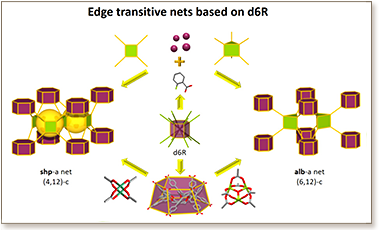

 Highly connected and edge-transitive nets are of prime importance in crystal chemistry and are regarded as ideal blueprints for the rational design and construction of metal-organic frameworks (MOFs). We report the design and synthesis of highly connected MOFs based on reticulation of the sole two edge-transitive nets with a vertex figure as double six-membered-ring (d6R) building unit, namely the (4,12)-coordinated shp net (square and hexagonal-prism) and the (6,12)-coordinated alb net (aluminum diboride, hexagonal-prism and trigonal-prism). Decidedly, the combination of our recently isolated 12-connected (12-c) rare-earth (RE) nonanuclear [RE9(μ3-OH)12(μ3-O)2(O2C-)12] carboxylate-based cluster, points of extension matching the 12 vertices of hexagonal-prism d6R, with 4-connected (4-c) square porphyrinic tetracarboxylate ligand led to the formation of the targeted RE-shp-MOF. This is the first time that RE-MOFs based on 12-c molecular building blocks (MBBs), d6R building units, have been deliberately targeted and successfully isolated, paving the way for the long-awaited (6,12)-c MOF with alb topology. Indeed, combination of a custom-designed hexacarboxylate ligand with RE salts led to the formation of the first related alb-MOF, RE-alb-MOF. Intuitively, we successfully transplanted the alb topology to another chemical system and constructed the first indium-based alb-MOF, In-alb-MOF, by employing trinuclear [In3(μ3-O)(O2C-)6] as the requisite 6-connected trigonal-prism and purposely made a dodecacarboxylate ligand as a compatible 12-c MBB. Prominently, the dodecacarboxylate ligand was employed to transplant shp topology into copper-based MOFs by employing the copper paddlewheel [Cu2(O2C-)4] as the complementary square building unit, affording the first Cu-shp-MOF. We revealed that highly connected edge-transitive nets such shp and alb are ideal for topological transplantation and deliberate construction of related MOFs based on minimal edge-transitive nets.
Highly connected and edge-transitive nets are of prime importance in crystal chemistry and are regarded as ideal blueprints for the rational design and construction of metal-organic frameworks (MOFs). We report the design and synthesis of highly connected MOFs based on reticulation of the sole two edge-transitive nets with a vertex figure as double six-membered-ring (d6R) building unit, namely the (4,12)-coordinated shp net (square and hexagonal-prism) and the (6,12)-coordinated alb net (aluminum diboride, hexagonal-prism and trigonal-prism). Decidedly, the combination of our recently isolated 12-connected (12-c) rare-earth (RE) nonanuclear [RE9(μ3-OH)12(μ3-O)2(O2C-)12] carboxylate-based cluster, points of extension matching the 12 vertices of hexagonal-prism d6R, with 4-connected (4-c) square porphyrinic tetracarboxylate ligand led to the formation of the targeted RE-shp-MOF. This is the first time that RE-MOFs based on 12-c molecular building blocks (MBBs), d6R building units, have been deliberately targeted and successfully isolated, paving the way for the long-awaited (6,12)-c MOF with alb topology. Indeed, combination of a custom-designed hexacarboxylate ligand with RE salts led to the formation of the first related alb-MOF, RE-alb-MOF. Intuitively, we successfully transplanted the alb topology to another chemical system and constructed the first indium-based alb-MOF, In-alb-MOF, by employing trinuclear [In3(μ3-O)(O2C-)6] as the requisite 6-connected trigonal-prism and purposely made a dodecacarboxylate ligand as a compatible 12-c MBB. Prominently, the dodecacarboxylate ligand was employed to transplant shp topology into copper-based MOFs by employing the copper paddlewheel [Cu2(O2C-)4] as the complementary square building unit, affording the first Cu-shp-MOF. We revealed that highly connected edge-transitive nets such shp and alb are ideal for topological transplantation and deliberate construction of related MOFs based on minimal edge-transitive nets.